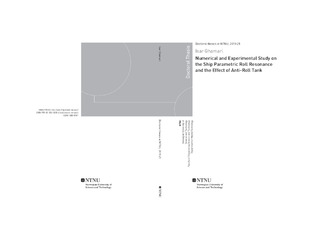| dc.description.abstract | The parametric resonance in roll motion (known shortly as parametric rolling) was studied for a fishing vessel and container ship in regular waves. This is an instability and resonance phenomenon that can lead the roll to reach very high oscillations amplitudes at its natural frequency, depending on the damping level involved. In the worst cases, it is responsible for vessel capsize. Here the problem was investigated numerically and experimentally, performing dedicated physical tests on a typical Norwegian fishing vessel with blunt hull and small length-to-beam ratio.
Different numerical solvers with different level of sophistication were developed and used to study the parametric rolling (PR) phenomenon, its occurrence and features. A 5-DOF numerical simulator was developed based on the Salvesen-Tuck-Faltinsen (STF) strip theory (Salvesen et al. [1]) formulation first and was validated for a post-Panamax C11 class container ship in regular waves. To study the PR for the fishing vessel, with beam-to-length ratio twice the ratio of studied container ship, 3D effects must be considered more adequately. Therefore, another simulator was developed based on a 6-DOF 3D hybrid method where the radiation and diffraction potentials were computed for zero forward speed by WAMIT and used in the STF strip theory to obtain speed dependent loads. The convolution integrals were used to account for the effect of radiation free-surface memory effect (Cummins [2]). The non-linear Froude-Krylov and restoring loads were calculated in each time step of the simulations, by integrating the undisturbed incident wave dynamic pressure and the hydrostatic pressure over the instantaneous wetted hull surface up to the undisturbed incident free surface and accounting for the body motions. It was observed that using weak-scatterer hypothesis in radiation and diffraction loads provides better results in long and steeper waves ([3], [4]). The coupling with horizontal motions also showed to be important in capturing the PR phenomenon. A dedicated experimental campaign was also carried out in the CNR-INSEAN test basin for the SFH112 fishing vessel. The tests were performed for the cases without forward speed and with forward speed, with corresponding Froude number Fn = 0.09 and Fn = 0.18. The tests were carried out with different wave frequencies and wave steepnesses. The numerical simulations showed good agreement with the experimental results. For the cases near the instability border, the physical and numerical predictions were different in terms of PR occurrence.
The effect of free-surface anti-roll tank on the PR was also studied experimentally and numerically. In the numerical simulation, a CFD sloshing solver, based on the "Open source Field Operation And Manipulation", known in short as Open-FOAM, and assuming 2D laminar flow conditions, was coupled to the main seakeeping simulator to account for the sloshing loads from the tank. From present studies, the tank-ship interaction cannot be modeled as a weak coupling. Here an iterative strategy was proposed, which proved to be successful when compared against established 2D experiments [5] and against our dedicated tests on the fishing vessel. In the experimental side, different tank sizes have been tested to study the tank effects in the PR region. The coupled simulator is validated based on the mentioned experimental data. The performed analysis suggests that a well designed anti-roll free surface tank could easily avoid the parametric rolling phenomena. | nb_NO |
